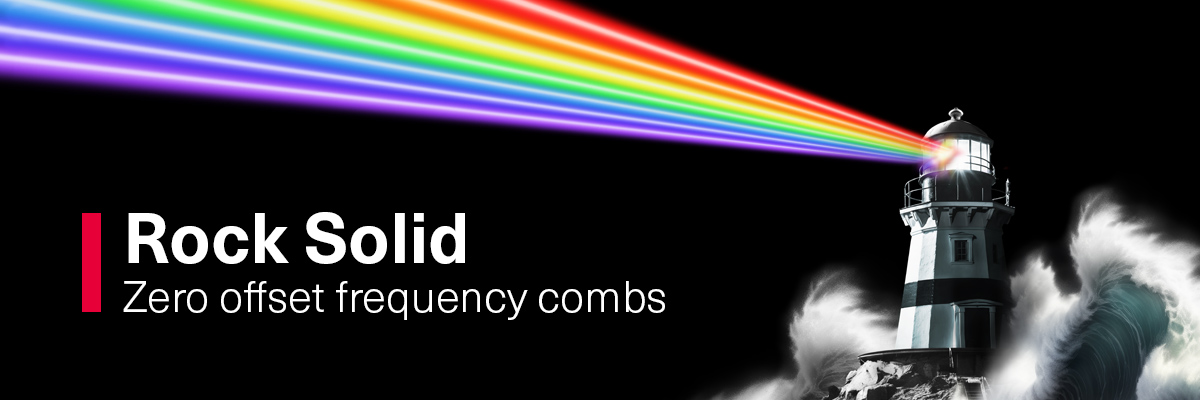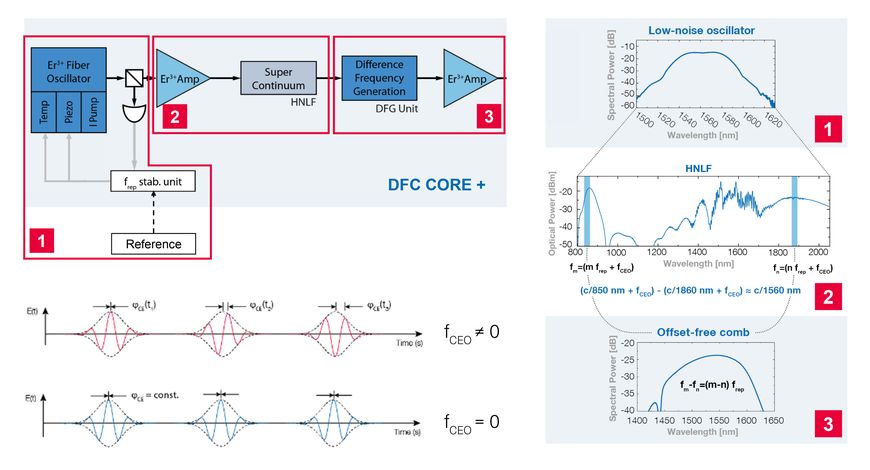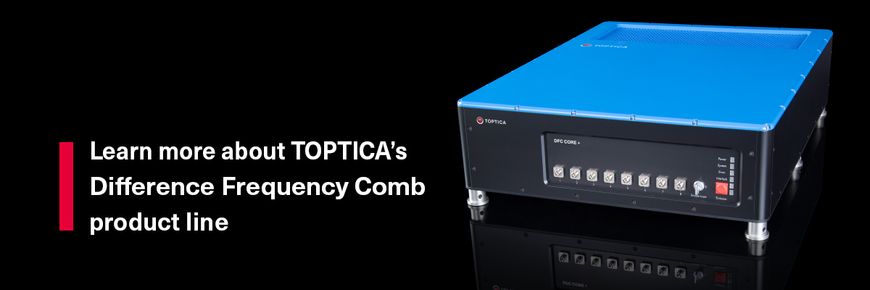We believe a frequency comb should be stable and reliable in every situation
Frequency combs are the robust and reliable backbone of an experiment. This thought is guiding our frequency comb product development. It’s the shared vision with our customers, who want to focus more on the actual research and spend less time maintaining their system.
CERO technology – zero fCEO
Our awarded CERO technology enables an inherently fCEO-stable frequency comb design that combines robustness with reliability and highest stability. The offset frequency fCEO of TOPTICA’s Difference Frequency Comb (DFC) is passively fixed to zero by utilizing a difference frequency generation (DFG) process for each optical pulse. This results in a reduced comb equation fn = fCEO + n · frep and multiple advantages for your experiment:
Perfect lock to optical reference

By fixing fCEO to zero with the DFG process we achieve exceptionally low noise at the frequency origin and completely decouple fCEO and frep.
This is particularly beneficial when the comb is stabilized to an optical reference like a narrow linewidth laser. Then the frequencies of the comb lines are tightly locked at 0 Hz and, additionally, at a high optical frequency (100s of THz) by the optical reference. Here, the CERO technology has a clear advantage over the conventional f-to-2f comb approach, since it also cancels high frequency noise components of fCEO. Thus, all comb lines perfectly inherit the phase noise from the optical reference.
By pinning the comb’s origin to 0 Hz the comb equation is simplified which leads to an extremely precise determination of the absolute laser frequency: fLaser = fCEO + n⋅frep ± fBeat
Ultra-low noise and narrow linewidth

The CERO technology uses a passive, all-optical phase-lock for stabilizing the offset frequency fCEO. By that our comb system requires one electronic locking loop less compared to conventional f-2f-combs. Hence, in TOPTICA’s frequency comb the fCEO contains no electronic noise (also not at high frequencies) which results in an unprecedented low carrier-envelope-phase (CEP) noise and a narrow free-running linewidth. With these properties TOPTICA’s DFC CORE + enables applications with stringent requirements on linewidth and phase noise.
100 times faster noise reduction

By utilizing a passive, all-optical lock the effective fCEO-locking-bandwidth of the DFC CORE +is as high as 200 MHz. By that it suppresses perturbations and noise 100 times faster compared to conventional f-2f-combs which are limited by the bandwidth of the electronic fCEO-stabilization. This makes TOPTICA’s Difference Frequency Comb more robust against external influences.
Additionally, the CERO Technology allows for a comb system with reduced complexity (one locking loop less) which is less prone to errors and therefore more reliable in daily use.
How it works
CERO-technology at a glance
The operating principle of the offset-free Difference Frequency Comb (DFC) relies on generating a broadband supercontinuum from the output of a low noise Er-fiber mode-locked oscillator and subsequent optical difference frequency generation (DFG) between the low- and high-frequency parts of the octave spanning spectrum in a nonlinear crystal. The most important features are an improved stability and a more simple and reliable, all passive frequency offset stabilization. The comb is free from fluctuations of the offset-phase and offset-frequency due to the common mode suppression of the two parts of the original spectrum. Additionally, the carrier envelope offset frequency fCEO of the DFC is fixed to zero.
- Generation of a broadband supercontinuum with Er3+-fiber oscillator and nonlinear fiber
- Difference frequency generation between the lower and upper spectral parts of the supercontinuum in a nonlinear crystal
- Both spectral parts have identical fCEO
- The resulting comb is carrier envelope phase stabilized and fCEO is fixed to zero
- TOPTICA patent (DE102004022037)
The passive all optical fCEO stabilization has distinct advantages with respect to the conventional f-to-2f-interferometer approach. This has been pointed out by several major players in the field of frequency metrology (Krauss et al., Opt. Lett, 36, 540 (2011)). The biggest advantage of the passive stabilization is that it is not limited by electronic noise. Additionally, no carrier envelope offset beat alignment or complicated drift compensation are required and the absence of carrier envelope offset locking electronics reduces the complexity of the electronics package significantly. The only adjustable parameter is the repetition rate of the DFC. It can easily be stabilized to any suitable radio frequency (RF) reference.
- DFG in the literature
TOPTICA's frequency comb DFC shows quadratic scaling of the phase noise with frequency. This textbook like behavior has been shown to a remarkable degree. The DFC behaves like an elastic tape with a true fixpoint at zero. An ideal system to be combined with an optical reference. Characterization of a DFG comb showing quadratic scaling of the phase noise with frequency,
T. Puppe et al., Optics Letters Vol. 41, Issue 8 (2016)“The DFG comb possesses a vanishing carrier envelope offset frequency that permits the construction of a simple and thus potentially more stable optical clockwork.“
Zimmermann, Gohle, Holzwarth, Udem and Hänsch, Opt. Lett., 29, 310 (2004)“This all passive approach provides extremely reliable and rigid locking of fCEO on both short and long time scales”,
Krauss, Fehrenbacher, Brida, Riek, Sell, Huber, and Leitenstorfer, Opt. Lett., 36, 540 (2011)“… in this nonlinear process the phases of the two pulses add up with different signs, leading to CEP cancellation and resulting in passive, all-optical phase stabilization.”
Manzoni, Cerullo, and De Silvestri, Opt. Lett., 29, 2668 (2004)“The unique feature … is that fCEO of the DF is zero without any servo-loop feedback system; i.e., the waveform is self-stabilized in the resultant pulse train.” “The generated phase-stable pulses may - after preamplification - be suitable for seeding high-gain Ti:sapphire amplifiers and (or) the oscillator itself.”
Fuji, Apolonski and Krausz, Opt. Lett., 29, 632 (2004)



